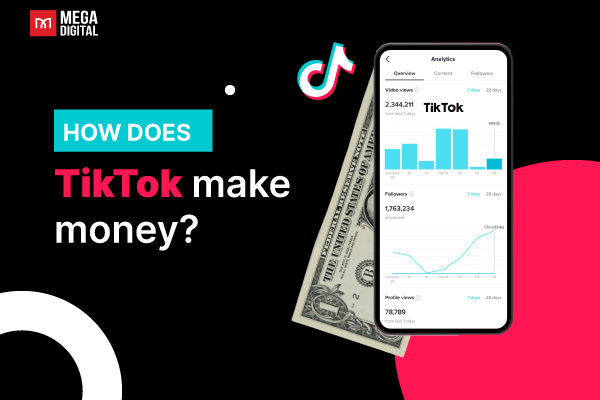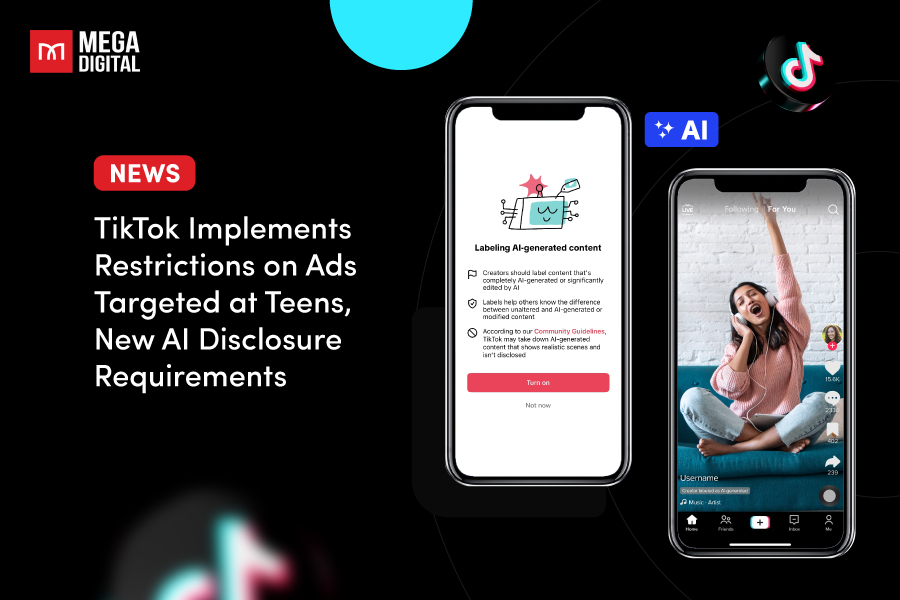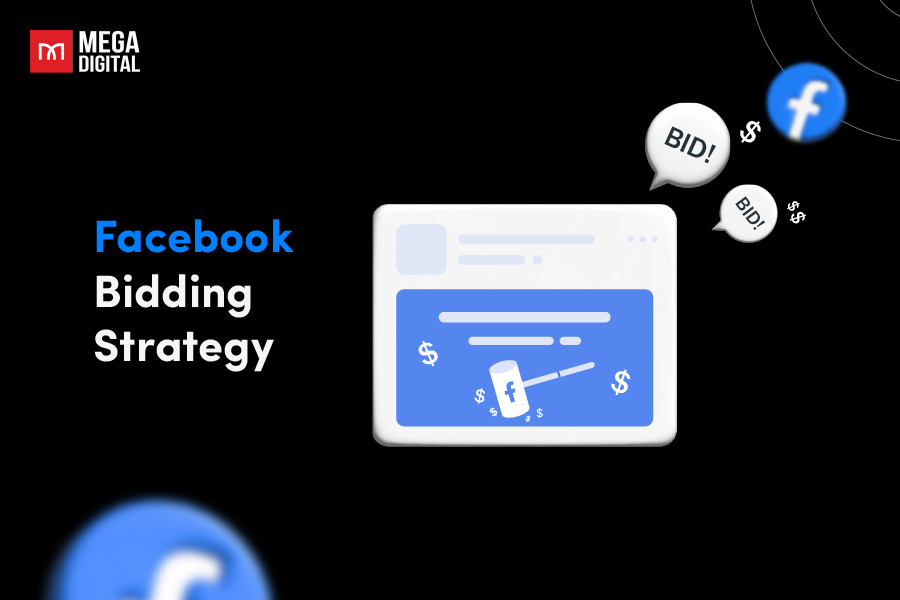To estimate the Facebook advertising cost, you need to understand how the platform calculates your advertising expenses, as well as the factors that affect that cost. In this blog post, I’ll break down the components of Facebook ad costs, and provide the most up-to-date and comprehensive data available about the average Facebook advertising cost to help you make informed decisions for your next campaign.
How does Facebook ad pricing work?
If you have ever run ads on any online platform, you’re likely familiar with the auction-based system that determines ad pricing. And this holds true for Facebook as well. The goal of the auction is to pair your ad with people in your audience who are most likely to be interested in it. This helps you get the most results possible for your budget while providing a positive, relevant experience for your customers.
When you create an ad, you set a budget and a bid. The budget is the total amount you’re willing to spend daily or throughout the campaign, and you can edit it at any time. The bid is the maximum amount you’re willing to pay when someone sees your ad or takes your desired action. Unlike traditional auctions that pick a winner based on the highest bid, this auction system looks at several factors equally to determine which ad is displayed:
- Advertiser bid: This represents how interested you are in showing your ad.
- Estimated action rates: This is calculated by how likely Facebook thinks a person will take the action you are optimizing for with your ad.
- Ad quality and relevance towards user: This is decided by how interested Facebook thinks a person will be in seeing your ad.
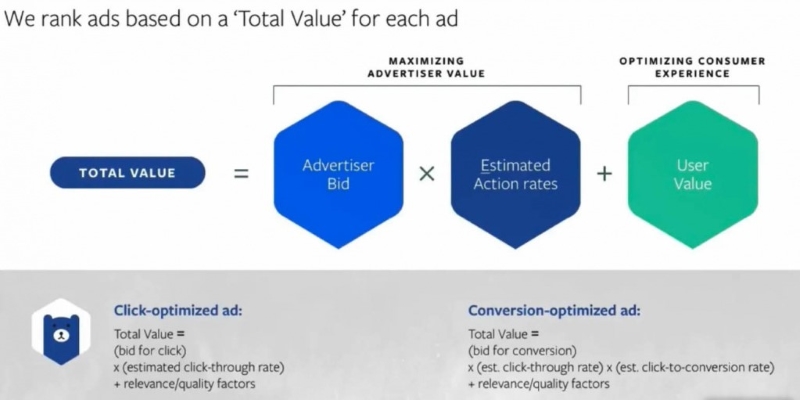
Using the information you provide in the ad creation process, the ad auction automatically shows your ad to the people most likely to be interested in what you offer. When your ad is shown or when people take your desired action, you’ll only pay the price you bid or less, never higher.
10 Factors influencing Facebook advertising cost
Understanding the factors that influence the cost of a Facebook ad can help you optimize your advertising strategy and get the most out of your budget. Here are 10 key factors that can affect the cost of your Facebook ads:
Target audience
When you enter the bidding battle for ad placement, you’re not just up against businesses within your own sector, but also those from diverse industries. Consequently, if your target audience is highly sought after by other advertisers (for example, high-income consumers), you may find yourself in a bidding war, driving up costs. The demographics, interests, and behaviors of your target audience can significantly impact the cost of your ads.
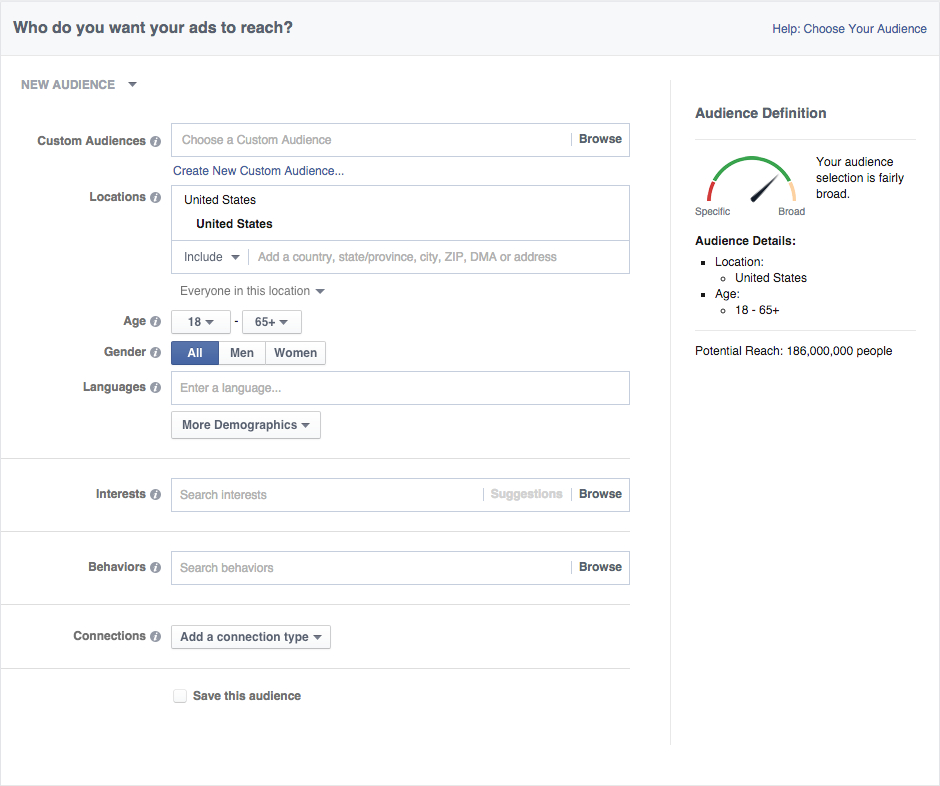
Ad quality
As I have said above, Facebook uses an auction system for its ad space. Ads that are high-quality and relevant to the audience not only perform better but can also cost less. This is because Facebook rewards ads that provide a good user experience with lower costs and better placement.
Ad placement
If the competition for your ad placement is high, the cost of your ads will increase. To put it simply, ad spots on Facebook with greater visibility (such as the News Feed) will cost more than those in less visible areas. Facebook offers a variety of ad placements across its family of apps and services, including Instagram, Messenger, and the Audience Network, to help you broaden your reach and attract more customers. Costs can vary depending on where your ad is placed.
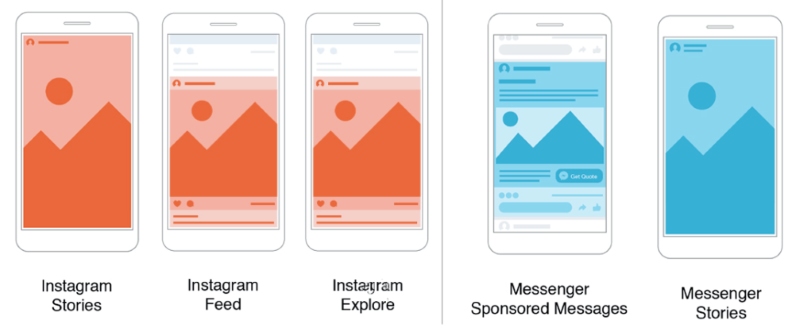
Bidding strategy
The choice of Facebook ad bidding strategy can significantly affect the cost of Facebook advertising:
- Bidding Strategy: The bidding strategy you choose determines how Facebook’s algorithm bids for you in ad auctions. For instance, you can set a campaign, ad set, or ad live, and decide how to compete within the auction to ensure that your ad is being presented to the right people at the right time, according to your budget and business goals.
- Bid Cap: Bid Cap is one of Facebook’s bid strategy options, which guides Meta on how to bid in the ad auction. A Bid Cap sets a maximum bid across auctions, rather than allow them to bid dynamically.
- Lowest Cost: Lowest Cost is the default bid strategy, and it doesn’t involve any effort at all. If you leave the cost control field blank, Facebook will aim to get the most results possible from your budget.
- Cost Cap: If you enter a Cost Control, Facebook will automatically use Cost Cap. In some cases, you’ll be able to edit the bid strategy and change to the Bid Cap Bid Control. If you use Cost Cap, Facebook will try to keep the average Cost Per Action at or below the cost control that you set.
Ad budget
About bidding budget, this is the amount of money you want to spend on showing people your ads. It’s a cost control tool that helps control your overall spending for a campaign or ad set, the same way a bid strategy helps control your cost per result. If you set a higher budget, Facebook will try to use all of it, which might increase the overall cost. You can still make a small budget work for your company, however, its performance limitations provide fewer conversions for your brand.
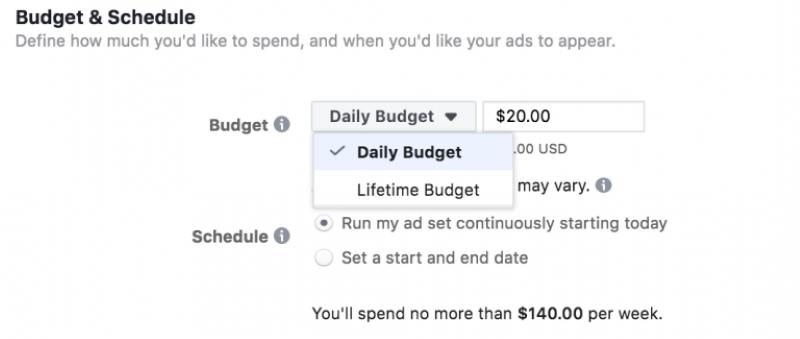
Ad objective
Facebook offers several ad objectives, including brand awareness, traffic, and conversions. The objective you choose can impact your costs as it determines how Facebook optimizes your ad delivery. Setting the right campaign objective is the most important thing you can do to optimize your expense on a Facebook ad (and ensure success, too).
Industry
Certain industries face fiercer competition than others when it comes to digital advertising, leading to an impact on advertising expenses. Generally, as the price of your product or the value of the leads you aim to attract increases, so do your advertising costs.
For example, industries like finance, legal services, B2B, and insurance often have higher advertising costs due to high competition and higher customer lifetime values.
Season of the year
Certain times of the year are just popular for advertising. You might easily notice this trend during holiday seasons such as Christmas or Black Friday, when there’s typically a surge in advertising as businesses compete to reach consumers, leading to increased ad costs. During these times, more businesses are bidding for ad space, which can drive up costs.
Some of the most costly days to advertise on Facebook are:
- Thanksgiving
- Black Friday
- Cyber Monday
- Christmas
- Boxing Day
- New Year’s Eve
- New Year’s Day
Time of the day
The time of day can significantly impact the cost of Facebook advertising. By default, ads operate round the clock. But during peak hours, when more users are active on the platform, the competition for ad space increases, leading to higher bid prices. Conversely, during off-peak hours, such as late at night or early in the morning, fewer advertisers are bidding for ad space, which can result in lower costs.
However, it’s important to note that while costs may be lower during off-peak hours, the number of users active on the platform is also likely to be lower. This means that while your cost per ad might be less, the total number of users you can reach may also decrease.
Country
Advertising costs can vary significantly from country to country. This is due to a variety of factors, including the average income level, the level of competition in the digital advertising space, and the size of the population. For example, countries with a larger number of Facebook users may have higher competition for ad space, leading to increased costs. Also, developed countries often have higher advertising costs due to higher purchasing power and advertiser demand.
How much does Facebook advertising cost?
Average Cost Per Click (CPC)
The average CPC on Facebook in January 2024 is $0.584. This means that, on average, businesses pay around 50-60 cents each time someone clicks on their ad on Facebook.
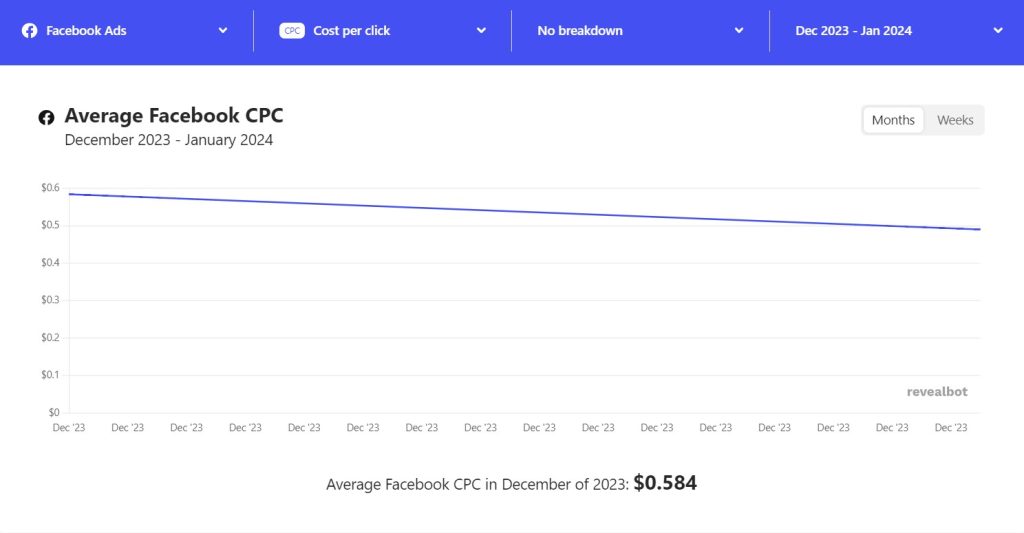
Average Cost Per 1000 Impressions (CPM)
The average CPM on Facebook in January 2024 is $10.61. This means that businesses pay between $10 and $11 for every 1000 times their ad is shown, regardless of how many clicks it gets.
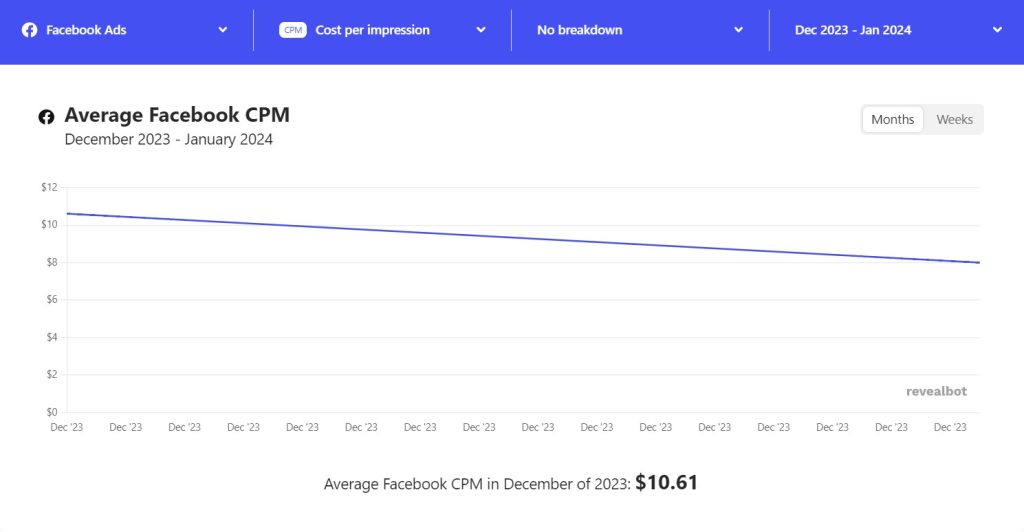
Average Cost Per Engagement (CPE)
The average CPE in January 2024 is $0.079.
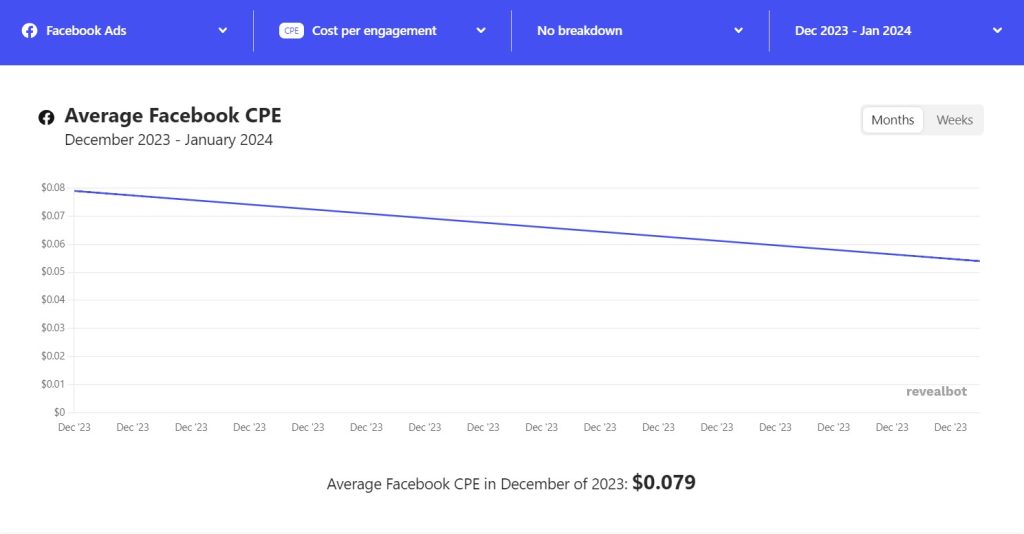
Average Cost Per Lead (CPL)
The average CPL in January 2024 is $10.08.
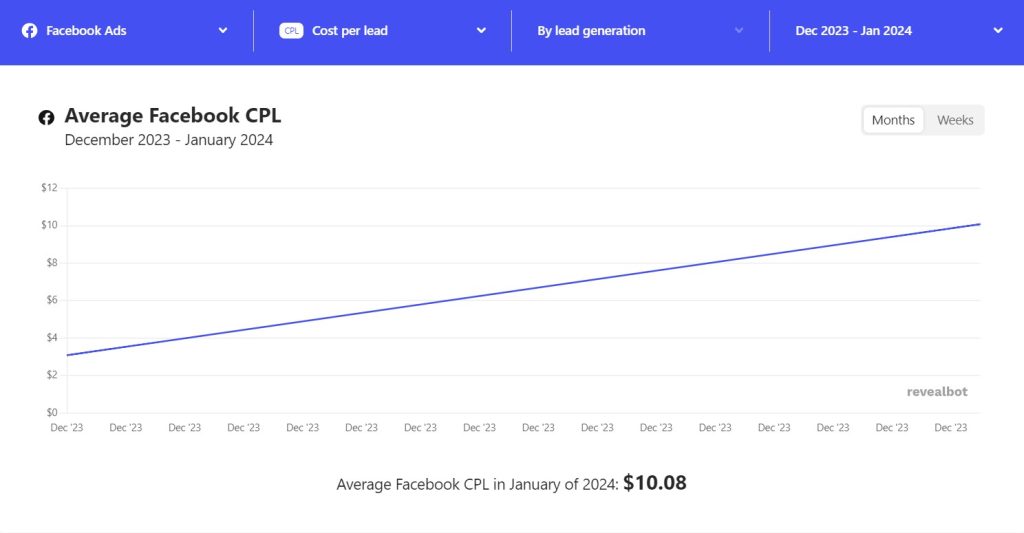
Average Cost Per Install (CPI)
The average CPI (for mobile devices) in January 2024 is $0.998.
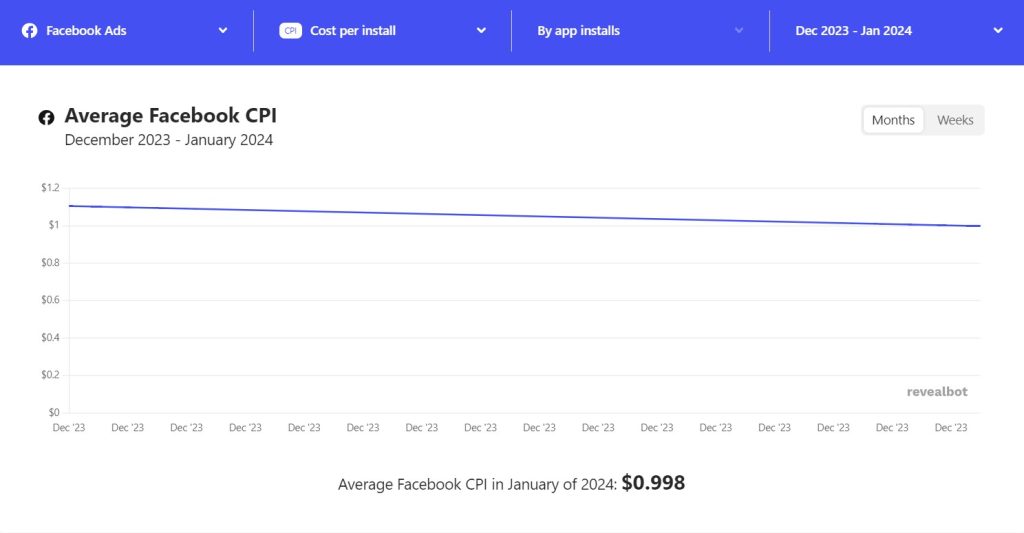
Tips to reduce your Facebook advertising cost
Facebook is becoming a reliable source of attracting new customers and retaining old ones for your business. You don’t want to just pour your marketing budget down the drain by spending ad expenses on the wrong target audience or at the wrong time.
Here are some tips for you to reduce your Facebook ad cost, while still making the most out of it:
Choose the right campaign objective
That might sound like “cliché” advice, but some advertisers still waste a lot of their ad costs by setting the wrong campaign objective. Basically, the campaign objective is the action you want people to take when they see your ads. Facebook offers several campaign objectives, each of which corresponds to a different stage in the sales funnel, from awareness to conversion.
Facebook optimizes your ad delivery based on your campaign objective. This means that Facebook will show your ads to people who are most likely to take the action you’re optimizing for. By choosing the right objective and optimizing for it, you can reach the right people and reduce your cost per result.
Be specific enough with your target audience
The larger your audience is, the more businesses you’re competing with. Narrow down your audience to ensure only individuals who are most likely to be interested will see your ads, while also decreasing your Cost per Click (CPC). Running highly targeted campaigns gives you a distinct advantage: you know exactly who you’re targeting, so you can craft ads and offers that you know they’ll be receptive to.
But remember, if your audience is way too specific, it may cost more to reach your relevant audience. Also, you may miss out on potential customers out there.
Learn More: Mastering Facebook Ad Targeting with These 6 Useful Strategies
Lower your ad frequency score
Ad frequency refers to the average number of times each person sees your ad. A high ad frequency can lead to ad fatigue, where your audience becomes less responsive to your ad because they’ve seen it too many times. This can result in lower engagement rates and higher costs. Keep an eye on your ad performance metrics. If you notice your costs rising and your engagement dropping, it may be a sign that your ad frequency is too high.
Regularly update your ad creative (images, videos, and text) to keep it fresh and engaging. This can prevent ad fatigue and maintain a lower ad frequency. Also, Facebook allows you to set a frequency cap, which limits the number of times your ad is shown to the same person within a certain time.
Do A/B testing with different ad creatives and placements
A/B testing, also known as split testing, is crucial if you want to know which variables work out the best for your marketing campaigns.
To conduct an A/B test, you either duplicate an existing campaign, ad set, or ad and change a variable, or compare two existing campaigns or ad sets. Our experts recommend using the same budget for both versions in a test to ensure a fair comparison.
A/B testing can help you identify which ad creatives and placements resonate most with your audience, and which doesn’t. Therefore, you can optimize your ads for better performance at lower costs.
Improve the post-click experience
The post-click experience is just as important as the pre-click one. If you direct people to a slow or poorly executed website or landing page, they’ll just leave right away, carrying with them a negative experience about your business. This equals a lower conversion rate and more costly ads.
A seamless and engaging post-click experience can increase the likelihood of conversions, thereby improving your ad’s performance and potentially reducing costs. This includes factors like page load speed, mobile optimization, clear and compelling call-to-actions, and easy navigation. You need to optimize the entire marketing funnel with great care to make sure your users have a good experience in their journey, from click to purchase, and beyond.
Use retargeting
Retargeting is an effective way that involves showing ads to people who have already interacted with your brand in some way. This could include people who have visited your website, engaged with your content on Facebook, or filled out an online form. Retargeting campaigns aim at people who already know and have trust, to some degree, with your brand. These users are more likely to convert, which can lower your cost per conversion.
Work with a trusted Facebook Ads agency
Running ads on Facebook might seem like a complex task, even if you are a pro in this field. There’s a multitude of factors to take into account and sometimes, the expense of your Facebook ads can be disheartening. Engage an experienced Facebook Ads agency to help you economize on ad expenses and ensure the success of your campaigns.
Conclusion
In conclusion, understanding Facebook advertising cost is a crucial step toward optimizing your ad spend and maximizing your return on investment. From bidding and audience targeting to ad placement and seasonal trends, each factor plays a unique role in determining the cost of your Facebook ads.







